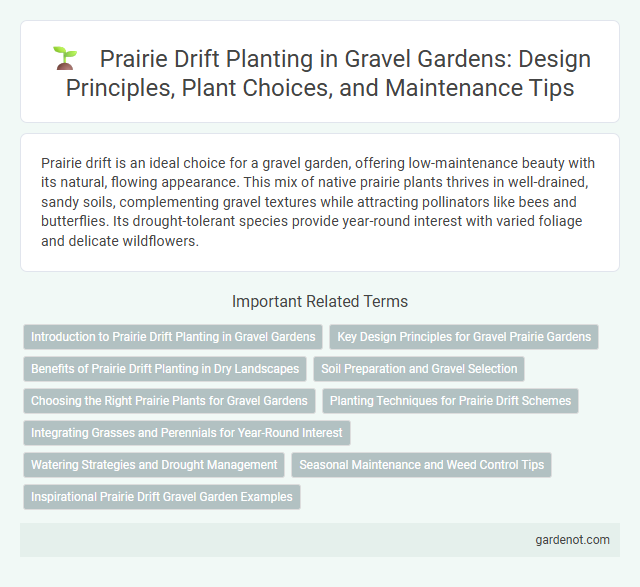Prairie drift is an ideal choice for a gravel garden, offering low-maintenance beauty with its natural, flowing appearance. This mix of native prairie plants thrives in well-drained, sandy soils, complementing gravel textures while attracting pollinators like bees and butterflies. Its drought-tolerant species provide year-round interest with varied foliage and delicate wildflowers.
Introduction to Prairie Drift Planting in Gravel Gardens
Prairie drift planting in gravel gardens integrates native grasses like Little Bluestem and Switchgrass with resilient wildflowers such as Black-eyed Susan and Purple Coneflower, creating dynamic, low-maintenance landscapes. This method emphasizes naturalistic design principles that enhance biodiversity while conserving water through drought-tolerant species thriving in well-drained gravel substrates. The layering of plant heights and textures mimics prairie ecosystems, offering seasonal interest and habitat value in urban or dry garden settings.
Key Design Principles for Gravel Prairie Gardens
Prairie drift gravel gardens emphasize naturalistic planting with native prairie species arranged in flowing drifts to mimic wild landscapes. Key design principles include selecting drought-tolerant, deep-rooted grasses and perennials that thrive in well-drained, gravelly soils, promoting sustainability and low maintenance. Incorporating varied textures and seasonal interest enhances biodiversity and creates dynamic, resilient garden ecosystems.
Benefits of Prairie Drift Planting in Dry Landscapes
Prairie drift planting in dry landscapes significantly enhances soil stability and reduces erosion by establishing deep-rooted native grasses and wildflowers adapted to low water conditions. This planting method supports drought resilience, promoting biodiversity by providing habitat for pollinators and native wildlife. The diverse species mix improves nutrient cycling and reduces the need for irrigation and chemical inputs, making it an eco-friendly choice for sustainable landscaping.
Soil Preparation and Gravel Selection
Prairie Drift thrives in well-drained soil enriched with organic matter, requiring thorough soil preparation to ensure proper aeration and moisture retention. Using angular gravel with a 5-10mm size range optimizes drainage and prevents soil compaction around plant roots. Selecting gravel that complements the natural prairie aesthetic enhances both functionality and visual appeal in the garden.
Choosing the Right Prairie Plants for Gravel Gardens
Choosing the right prairie plants for gravel gardens involves selecting species that thrive in well-drained, nutrient-poor soils typical of gravel settings. Native grasses such as little bluestem (Schizachyrium scoparium) and purple lovegrass (Eragrostis spectabilis) provide strong structural form, while wildflowers like blazing star (Liatris spicata) and black-eyed Susan (Rudbeckia hirta) offer vibrant seasonal color and support local pollinators. Emphasizing drought-tolerant and deep-rooted plants enhances resilience, reduces maintenance, and ensures sustainable growth in prairie drift gravel gardens.
Planting Techniques for Prairie Drift Schemes
Prairie drift planting techniques emphasize naturalistic layering with dominant native grasses such as Little Bluestem (Schizachyrium scoparium) and Switchgrass (Panicum virgatum) to create dynamic textures and movement. Strategic placement of wildflowers like Purple Coneflower (Echinacea purpurea) and Black-eyed Susan (Rudbeckia hirta) ensures continuous seasonal interest and supports pollinator habitats. Soil preparation involves minimal disturbance and incorporation of organic matter to mimic prairie conditions, promoting deep root establishment and drought resilience in gravel garden environments.
Integrating Grasses and Perennials for Year-Round Interest
Prairie Drift combines native grasses like Little Bluestem and Switchgrass with vibrant perennials such as Black-eyed Susan and Purple Coneflower to create dynamic textures and colors throughout the seasons. This gravel garden design ensures continuous visual appeal by leveraging the natural resilience and drought tolerance of prairie species. Strategic placement enhances biodiversity and supports pollinators, making Prairie Drift both sustainable and aesthetically engaging year-round.
Watering Strategies and Drought Management
Prairie Drift combines drought-tolerant native grasses and wildflowers, making it ideal for gravel gardens with minimal watering needs. Deep, infrequent irrigation supports root development and reduces water waste, aligning with sustainable landscaping practices. Mulching around plants helps retain soil moisture and suppress weeds, enhancing drought resilience in prairie ecosystems.
Seasonal Maintenance and Weed Control Tips
Prairie drift plants thrive with seasonal maintenance, including cutting back dead foliage in early spring to encourage healthy growth. Regular weeding prevents invasive species from competing for nutrients, especially during the growing season when weeds are most aggressive. Applying a layer of mulch helps retain moisture and suppress weed emergence, reducing maintenance efforts for a vibrant gravel garden.
Inspirational Prairie Drift Gravel Garden Examples
Prairie Drift Gravel Garden designs showcase naturalistic planting combined with durable gravel groundcover, creating low-maintenance, drought-tolerant landscapes perfect for sustainable gardening. Notable examples include native prairie grasses such as Little Bluestem (Schizachyrium scoparium) and Purple Coneflower (Echinacea purpurea) harmoniously integrated with angular granite gravel, enhancing both texture and soil drainage. These inspirational designs emphasize biodiversity, habitat creation for pollinators, and year-round visual interest through seasonal color variation.
Prairie drift Infographic

 gardenot.com
gardenot.com